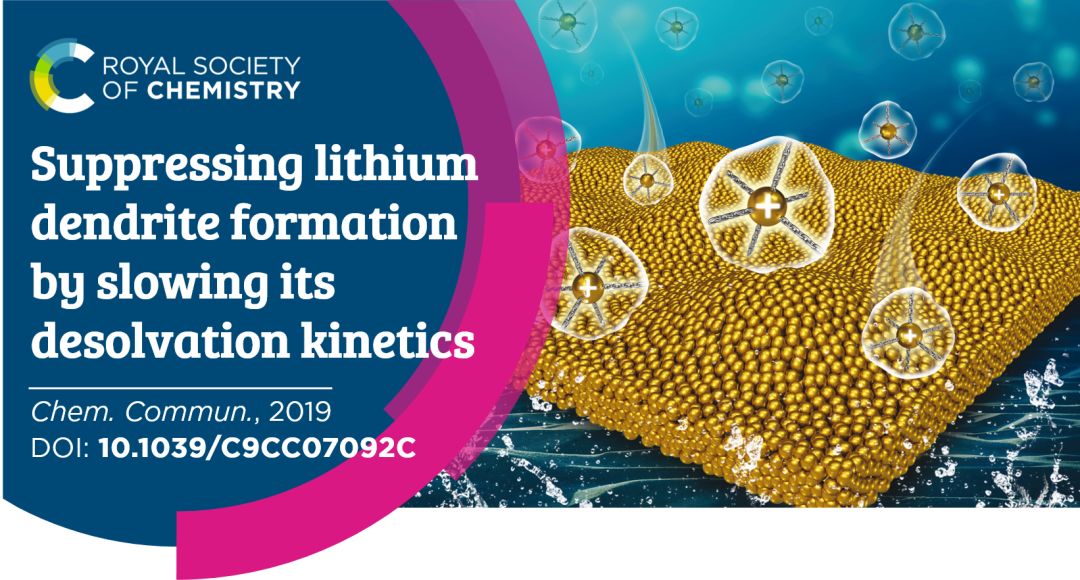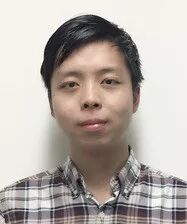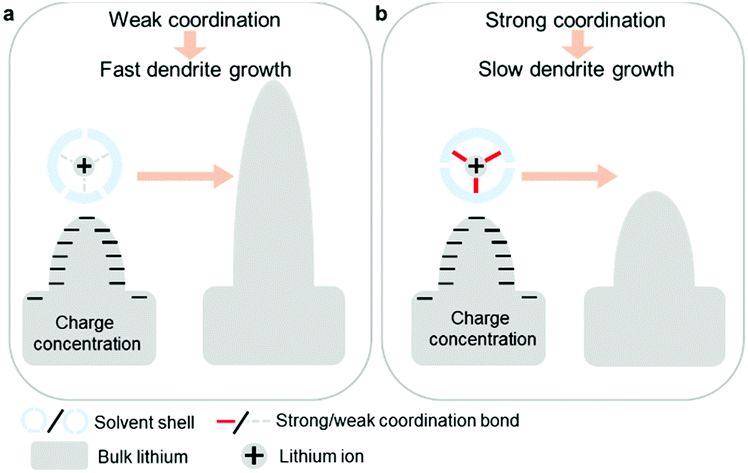

锂金属电池是一类能量密度比锂离子电池更高的可充电电池。其能量密度的提升来源于负极材料——具有极高理论比电容 (3860 mAh/g) 的锂金属。然而,在充电过程中,锂金属表面可形成锂枝晶。若枝晶生长并穿刺隔膜接触正极后会造成电池短路、起火甚至爆炸。
中科院沈阳金属所李峰研究员课题组近日找到了一种减缓锂金属电池中锂枝晶生长的有效策略:通过调节电解液成分,加强锂离子与溶剂之间的配位强度。该工作目前已发表在 Chemical Communications 上 (DOI: 10.1039/C9CC07092C)。
研究者们向电解液后中引入了一种添加剂——乙二醇二甲醚 (TEGDME)——与锂离子配位。相比于电解液的其他组分,乙二醇二甲醚 (DME) 和 1,3-二氧戊环 (DOL),TEGDME 含更多氧原子,能与锂离子形成多个配位键,产生更强的配位作用(图 1)。密度泛函理论计算表明,当添加了 TEGDME 后,锂离子和电解液之间的作用力提升了 0.31 eV,绝对值达 4.93 eV。增强溶剂配位作用升高了锂离子脱溶剂过程(锂枝晶生长的必要步骤之一)的活化能,从而减缓锂枝晶生长速率、延长电池寿命。

▲
图 1. 不同配位作用强度的电解液中锂枝晶生长示意图:(a) 弱配位作用利于锂枝晶快速生长;(b) 强配位作用阻碍锂枝晶生长。
为检验以上分析,作者们组装了两种锂金属电池并测试了它们的循环稳定性。其一含有 TEGDME+DME+DOL 电解液,另一种使用 DME+DO 电解液。充放电循环稳定性测试显示,前者在 1C 电流密度下、60 次充放电后电容量能保持在 80%。在相同测试条件下,后者电容量在 30 次充放电后便快速衰减(图 2a)。此外,不含 TEGDME 电解液的锂金属电池负极的扫描电镜图像中存在多个棒状枝晶(图 2b),而含 TEGDME 电解液的锂金属电池负极表面沉积物呈团状,无明显枝晶(图 2c)。该结果进一步证明了 TEGDME 可阻碍锂枝晶生长。

▲
图 2. 两种锂金属电池的充放电循环稳定性:(a) 含 TEGDME 与无 TEGDME 电解液。(b) 无 TEGDME 电解液与 (c) 含 TEGDME 电解液的锂金属负极在充电后的表面形貌。
本工作展现了调控锂金属电池电解液成分对于维持电池稳定性和安全性的重要性。
本报道作者

刘田宇 博士
2012 年毕业于北京科技大学化学系,获理学学士学位。2017 年毕业于美国加州大学圣克鲁兹分校 (University of California, Santa Cruz),获物理化学博士学位。主要研究方向为微、纳米材料(特别是多孔碳材料)的制备及其在电化学能源转化和存储领域中的应用。目前担任英国皇家化学会旗下化学类期刊 Chemical Communications 官方博客博主。更多信息请参见其个人主页:http://liutianyuresearch.weebly.com/
论文信息Suppressing lithium dendrite formation by slowing its desolvation kinetics
Huicong Yang, Lichang Yin, Huifa Shi, Kuang He, Hui-Ming Cheng and Feng Li*
Chem. Commun., 2019
http://dx.doi.org/10.1039/C9CC05515K

关于 ChemComm

Urgent high quality communications from across the chemical sciences.

ChemComm
化学科学相关研究领域最新的高水平科研快讯IF: 6.164 *Chair
Véronique Gouverneur
University of Oxford, UK
Associate editors
Penny Brothers
Australian National University, Australia
Rachel Caruso
University of Melbourne, Australia
Steven De Feyter
KU Leuven, Belgium
Antonio Echavarren
Institute of Chemical Research of Catalonia, Spain
Daniel Gamelin
University of Washington, USA
Itaru Hamachi
Kyoto University,
Michael Krische
University of Texas at Austin, USA
Can Li
Dalian Institute of Chemical Physics, China
李灿,中科院大连化物所
Amy Prieto
Colorado State University, USA
S Ramakrishnan
Indian Institute of Science, India
Jean-Louis Reymond
University of Berne, Switzerland
Manfred Scheer
University of Regensburg, Germany
Jonathan L Sessler
University of Texas at Austin, USA
Jonathan W Steed
Durham University, UK
T Don Tilley
University of California, Berkeley, USA
Sandeep Verma
Indian Institute of Technology Kanpur, India
Scope
ChemComm (Chemical Communications) is renowned as the fastest publisher of articles providing information on new avenues of research, drawn from all the world's major areas of chemical research.
ChemComm publishes 100 issues per year, the first chemistry journal to do this, resulting in even faster times to publication and increased visibility.
The journal publishes a number of web themed issues on cutting edge areas of chemical research. From 2011, an Emerging Investigator issue is published on an annual basis.
ChemComm is now offering authors the option of double-blind peer review, in addition to single-blind peer review.
* 2018 Journal Citation Reports ? (Clarivate Analytics, June 2019)


欢迎联系我们发布论文报道
? RSCChina@rsc.org
